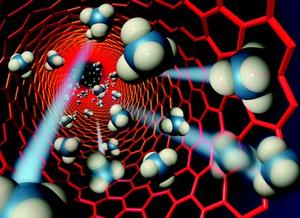WaterDiscoveries in nanotechnology to make clean, fresh drinking water more plentiful
The University of Chicago and Ben-Gurion University of the Negev will begin funding a series of ambitious research collaborations that apply the latest discoveries in nanotechnology to create new materials and processes for making clean, fresh drinking water more plentiful and less expensive by 2020.

Rendering of methane molecules moving through a nanotube // Source: dartmouth.edu
The University of Chicago and Ben-Gurion University of the Negev will begin funding a series of ambitious research collaborations that apply the latest discoveries in nanotechnology to create new materials and processes for making clean, fresh drinking water more plentiful and less expensive by 2020.
The announcement came 23 June following a meeting in Jerusalem among Israeli president Shimon Peres, Chicago mayor Rahm Emanuel, University of Chicago president Robert J. Zimmer, Ben-Gurion University president Rivka Carmi, and leading scientists in the field. The joint projects will explore innovative solutions at the water-energy nexus, developing more efficient ways of using water to produce energy, and using energy to treat and deliver clean water.
A University of Chicago release reports that the University of Chicago also brings to the effort two powerful research partners already committed to clean water research: the Argonne National Laboratory in Lemont, Illinois, and the Marine Biological Laboratory in Woods Hole, Massachusetts.
“We feel it is critical to bring outstanding scientists together to address water resource challenges that are being felt around the world, and will only become more acute over time,” said Zimmer. “Our purification challenges in the Great Lakes region right now are different from some of the scarcity issues some of our colleagues at Ben-Gurion are addressing, but our combined experience will be a tremendous asset in turning early-stage technologies into innovative solutions that may have applications far beyond local issues.”
The first wave of research proposals include fabricating new materials tailored to remove contaminants, bacteria, viruses, and salt from drinking water at a fraction of the cost of current technologies; biological engineering that will help plants maximize their own drought-resistance mechanisms; and polymers that can change the water retention properties of soil in agriculture.
UChicago, BGU, and Argonne have jointly committed more than $1 million in seed money over the next two years to support inaugural projects, with the first projects getting under way this fall.
One proposed project would attempt to devise multi-functional and anti-fouling membranes for water purification. These membranes, engineered at the molecular level, could be switched or tuned to remove a wide range of biological and chemical contaminants and prevent the formation of membrane-fouling bacterial films. Keeping those membranes free of fouling would extend their useful lives and decrease energy usage while reducing the operational cost of purifying water.
Another proposal focuses on developing polymers for soil infusion or seed coatings to promote water
